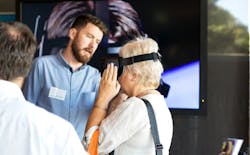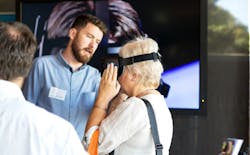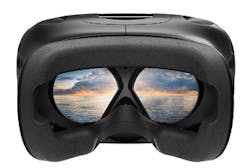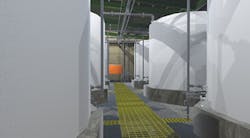Going virtual
How virtual reality can benefit water sector infrastructure design
Virtual reality (VR) technologies have emerged into the mainstream. Across the water sector, VR is already delivering results in design, planning, and operating assets.
By William Steel
Melbourne Water found 20 plant design faults using VR, compared to six using an old approach
Experiences of Australia’s Melbourne Water utility illustrate several successes to be had with VR technology in the context of plant design and human factors. The organisation has seen the value of VR, and how it enables identification of design defects and other health & safety risks during early phases of project development sooner than otherwise possible.
“We’ve been playing with VR for 18 months in the safe assets team to address a core struggle: a tension between designers and plant technicians and operators,” says Scott McMillan, Melbourne Water technology and innovation safety manager. “To build a robust plant system, you need collaboration between these groups, but that’s not easy to establish off blueprints.”
Melbourne Water’s first experience with VR came last year, when it was trialed against traditional hazard identification methods - a lengthy review process that involved a cross-functional group of operators, technicians and management reviewing CAD drawings, process and instrumentation diagrams, and other blueprints in order to feedback concerns to designers.
“With the old approach, we picked up just six problems. In VR, where users can walk through the plant, we found 20. It’s clear to us that a VR perspective is a massive step forward for design review,” says McMillan.
The hazards identified may seem subtle - the height of control room windows looking out onto tank systems or valve heights that weren’t so ergonomic, for instance. Yet, McMillan describes how small design issues, not recognised in early phases by designers, can manifest into significant occupational health and safety issues for plant staff. “Not only can these issues present risks, ultimately they can impact operation and maintenance of plants,” he adds.
While McMillan explains these design amendments stand to make plants more efficient, simpler, or safer, and ultimately more cost-effective with less downtime, he notes: “It’s hard to quantify tangible gains at this stage but it’s clear that VR is not a gimmick. There’s some real business uses out there.”
“We’ve now embedded [VR] in design processes as a mandatory requirement for any major project, and we’re looking to bring that cross-functional group into the design process earlier on.”
The utility operates with a HTC Vive VR headset and gaming laptop setup - a highly portable system according to McMillan, “that can be transported to wherever we need it.”
Over ten Melbourne Water projects have made use of VR, but the utility is actively investigating other applications, including VR training and using the technology to involve citizens in infrastructure planning. Another use under development involves using 3D point cloud scanning to map kilometres of tunnels and plant galleries, and importing this into VR.
Virtual design in WAles
Welsh Water in the UK provides another fine example of a utility embracing progressive technology to advance operations. This year the utility will conclude a £32 million development of its Bryn Cowlyd Water Treatment Works to improve water quality for some 100,000 customers. Utilised throughout the plant’s design and development was a 360 degree digital projection technology called Igloo.
Speaking to WWi, Gareth Paske, programme and systems manager at Welsh Water, says: “With this site alone, aside from others we’ve now modelled with Igloo, the system has more than paid for itself through our identifying risks early, designing out problematic issues, and avoiding construction delays.”
Describing how Igloo aided in development, Paske says: “Igloo allows designers to engage more effectively with the project, and for site operatives to be inducted with how the plant will look once complete and provide their feedback.”
“To collaborate and explore the plant before it’s built allows colleagues to get their input into how that plant might operate in twelve or twenty-four months’ time - designing out issues in the digital world is beneficial because changes post-construction is very expensive.”
Another dimension: Melbourne Water operates with a HTC Vive VR headset and gaming laptop setup, which McMillan describes as “highly portable”
Igloo doesn’t involve VR headsets. Instead virtual models are projected onto screens. Yet Paske maintains this is the beauty of the system. Rather than an isolating experience, multiple colleagues can engage with one another and the plant environment in collaboration. Approximately six meters in diameter, Paske says that the Igloo is comfortable for up to eight people, “Engaging in the plant layout, exploring complexities of design, rehearsing the build process, identifying hazards, and much more all in the comfort of a safe, warm environment.”
WWi was shown the Igloo in operation and it’s plain to see how the set-up allows potential problems to be rapidly identified, conflicting priorities attended to, and solutions more easily articulated between stakeholders. “All this and more can be accomplished before designs proceed to construction - saving money, and leading to a better plant and more efficient, safer build,” says Paske.
He provides another intriguing example of the technology in action: sub-terrain modelling of the plant’s pressurised pipelines, cabling, and surface water removal. “Often many specialist teams model these systems independently; leading to collisions when plans are later merged. Instead, with Igloo we can quickly identify and design out conflicts in the digital world, so that by the time we get on site we’re ready to work efficiently.”
The Igloo is also facilitating health and safety planning, simulating lifts and installation of large pieces of equipment, and induction of new plant operators.
Welsh Water is already involved in other projects utilising Igloo; from the looks of it, many avenues of opportunity await beyond plant design. As the Igloo’s screens fill with aerial imagery of a Welsh village, a dense network of blue and red lines appear, denoting clean and wastewater underground pipes.
Paske comments: “We’re integrating Igloo with Google Earth and drone footage to model our underground assets, explore terrain under development, and enhance maintenance operations being undertaken around roads and urban areas.”
It’s all a new and promising perspective that lends itself to work of a water utility, particular for remote or difficult to reach locations.
a promising foundation
Behind these applications are of course software developers. Since 1999, long before the prominence of VR to have emerged in just the last few years, one such company, EON Reality, has been delivering training packages to a multitude of industries.
Ken Swain, chairman of EON Reality, speaks to WWi about the company’s activities; describing active involvement with the water sector dating back several years to the present day and collaboration with the United Nations Industrial Development Organization (UNIDO).
“Right now is almost certainly the most exciting time the VR industry has ever seen,” he says. “We already have a promising foundation for the water industry, but it’s only going to get better. Moving forward, these platforms are going to get much more powerful.”
VR has been used in over 10 Melbourne Water projects to date
EON’s work with UNIDO provides clear insight into the power of such virtual solutions. Explaining the background, Swain adds: “UNIDO identified several barriers to effective water or wastewater treatment in developing regions, and it was clear to us that VR and Augmented Reality (AR) offered means to make a difference.”
According to UNIDO, often it’s not simply the absence of treatment plants that a region suffers from, but a lack of trained and qualified operators to ensure plants operate optimally.
Since last year, EON’s UK studio team has been creating a VR training and skills assessment program, which was designed alongside water experts providing subject matter experience and content.
Incorporating a high-fidelity digital model of a high-end European WWTP plant reflecting current methods and systems, Swain explains that EON’s Aquatronics application provides an “optimised training and assessment environment” engaged with via a HTC Vive.
“Within [Aquatronics] we’ve built materials to train in health & safety, operation of equipment, and various predefined tasks. Knowledge can also be assessed too,“ he says. ”For instance, we can test risk identification or task performance involving maintenance and repair such as taking pH level or pressure readings on equipment.”
Swain describes a scenario where trainees begin a virtual run in a plant control room, checking instrument panels and reporting readings, before navigating one of several routes through the plant to solve some issue, taking further measurements and meeting objectives along the way. In another simulation, new employees familiarise themselves with plants in a safe, virtual, environment.
There are several advantages here, not least in terms of education where Swain says that “studies have shown that when people are exposed to virtual training, they learn faster and retain information better.” What’s more, there is the opportunity to deliver expert training from OEMs situated halfway around the world.
For companies and operators, virtual training, says Swain, is more effective in terms of speed and cost, while increasing access to training. “Even in Europe or the US, transporting people for training carries costs and challenges. Training for hazardous environments, or handling complex or expensive equipment, these scenarios lend themselves to VR training too.”
The UNIDO project is in its early stages of development with the project due to be completed by April next year. Swain says that the long term goal is to take training far further and deepen the package’s capabilities: “We hope to have whole models of individual pieces of equipment which may be operated in virtual worlds, or even stripped down for maintenance or repair.”
Any plant, or piece of equipment with CAD data could easily be modelled said Swain; and if CAD data isn’t available, scanning technologies can be utilised to import assets into a virtual scenario.
EON Reality’s Augmented and Virtual Reality (AVR) Platform also encompasses a platform called AR Assist. This adopts augmented reality (AR) technology to provide digital information and instructions on the fly - super-imposed over the user’s real-world field of view. It is based around what users are looking at and engaging with in the real world.
VR in integrated urban water management
Unsurprisingly, VR is also making its way into modelling of water assets on larger scales. Dr Peter Bach, a researcher at both Monash University, Australia and the Swiss Federal Institute of Aquatic Science & Technology specialising in integrated urban water management, is presently leading a project funded by the Australian government, which is developing such VR solutions for urban water planners.
As with earlier case studies, Bach highlights challenges of establishing a mutual understanding between stakeholders: “Often with urban planning you have people from multiple sectors, with conflicting needs, trying to work together,” he tells WWi.
“This is made harder when you need to engage this group with complex models or a diversity of data.”
Asset management - involving local municipality, utilities and private stakeholders - is a classic example, according to Bach.
“The question might be how to manage risk, manage operations, or can we agree on the solution? The use of ‘serious gaming’ and VR technology can achieve greater immersion into the problem and allows users to ‘experiment’ and observe the consequences of decisions in a risk-free environment. Alternatively, we can put an individual in the shoes of someone else, so that they can better understand their position and their constraints for decision making. This is proving to be a very valuable tool.”
Although presenting some computational challenges, Bach is excited about the notion of rendering dynamic models in VR too: “We’re looking into some real-time applications of VR, for instance simulating flooding or water pollution to see how infrastructure reacts, how water flows, and where problems arise.”
Another niche that VR could advance involves eliciting user preferences to certain environments and providing a means to begin quantifying user engagement via ‘interactive data collection methods’.
Bach describes one experiment: “We used a 360 degree camera to capture an environment featuring green infrastructure; we then created a Google street-view like simulation in a game engine through which users can move and look around.
“As they do so, we can track movement and gaze direction to understand how they’re reacting. It’s possible to see if designs are promoting the behaviours they intended to, are being somewhat noticed or even ignored.”
He adds: ”Through this VR-based interactive data collection method we’re now able to get data on human behaviour and perception that was not possible before and this is proving to be very useful.”
Going forward, Bach and his colleagues will try to relate this new approach to existing studies on how people perceive green environments; the end result he believes will be a far more holistic and collaborative approach to planning water systems in urban environments.
William Steel, based in Denmark, is a freelance contributor for WWi magazine.



